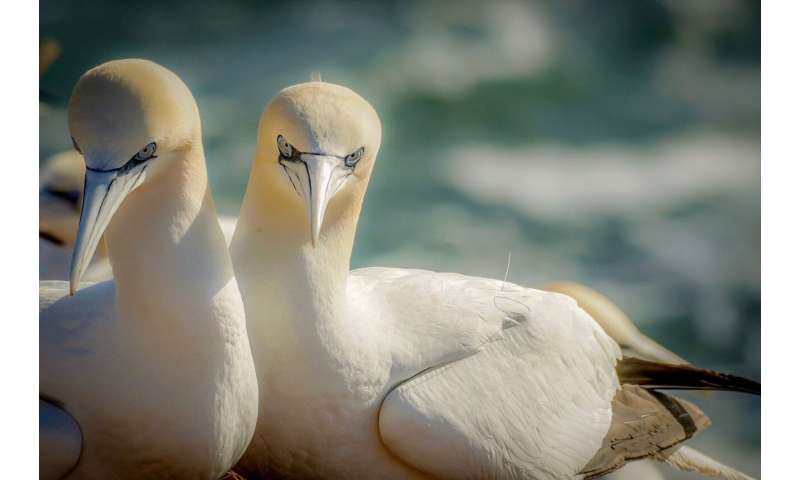Post by Eaglehawk on Jul 4, 2019 10:45:32 GMT
Northern Gannet - Morus bassanus
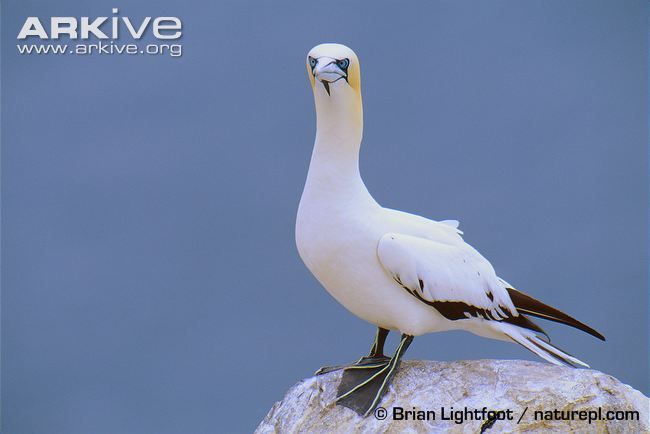
Scientific classification
Kingdom: Animalia
Phylum: Chordata
Class: Aves
Order: Suliformes
Family: Sulidae
Genus: Morus
Species: Morus bassanus
The Northern Gannet (Morus bassanus) is a seabird and is the largest member of the gannet family, Sulidae. It has the same colors as the Australasian Gannet and is similar in appearance. Nesting in colonies as large as 60,000 pairs, this bird is a spectacular high-speed diver.

Description
Young birds are dark brown in their first year, and gradually acquire more white in subsequent seasons until they reach maturity after five years.
Adults are 81–110 cm (32–43 in) long, weigh 2.2–3.6 kg (4.9–7.9 lb) and have a 165–180 cm (65–71 in) wingspan. Before fledging, the immature birds (at about 10 weeks of age) can weigh more than 4 kg (8.8 lb). Their plumage is white with black wing tips. The bill is light bluish. The eye is light blue, and it is surrounded by bare, black skin. During breeding, the head and neck are brushed in a delicate yellow.
Distribution
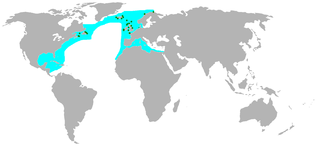
Their breeding range is the North Atlantic. They normally nest in large colonies, on cliffs overlooking the ocean or on small rocky islands. The largest colony of this bird, with over 60,000 couples, is found on Bonaventure Island, Quebec, but 68% of the world population breeds around the coasts of Great Britain and Ireland, with the largest colonies on the Bass Rock (whence the species' Latin name) and Boreray, St Kilda.
In the United Kingdom, Gannets are a protected species. However, a legal exception is made for the inhabitants of the district of Ness (also known as Nis) of the Isle of Lewis in Scotland's Outer Hebrides, who are allowed to cull up to 2,000 gannets (locally known as guga) annually to serve as a traditional local delicacy—the taste is described as fishy.
Many of these Gannets are taken from Sula Sgeir, which is itself named after them.
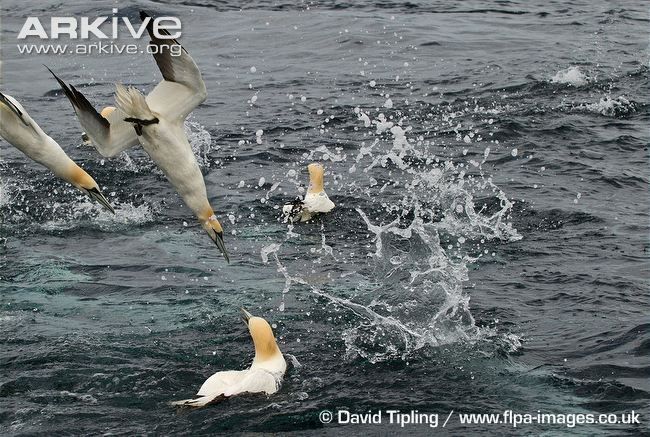
Ecology
Gannet pairs may remain together over several seasons. They perform elaborate greeting rituals at the nest, stretching their bills and necks skywards and gently tapping bills together.
They are migratory and most winter at sea, heading further south in the Atlantic.
When feeding, these birds are spectacular high-speed divers, plunging into the ocean from a height of 10–40 metres (33–130 ft), with their bodies straight and rigid, wings tucked close to the body but reaching back, extending beyond the tail, before piercing the water like an arrow. Their nearly vertical dive can reach speeds exceeding 100 km/h (60 mph) before entering the water, allowing them to penetrate 3–5 m (10–16 ft) below the surface, and occasionally swimming down to 12–15 m (40–50 ft). If the dive was successful, gannets will swallow the fish underwater before surfacing, and will never fly with the fish in its bill. Although they are strong and agile fliers, they are clumsy during takeoffs and landings.
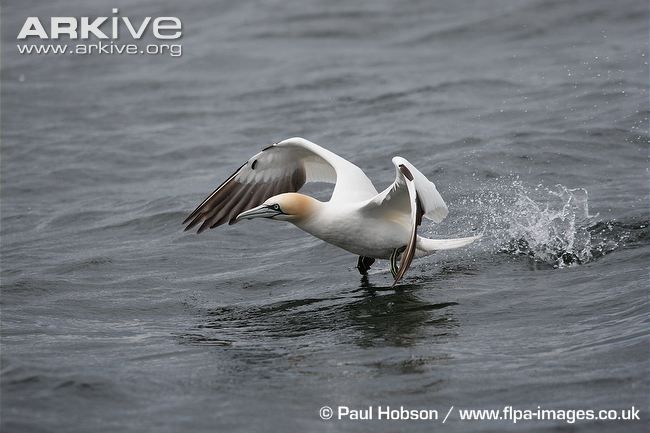
They mainly eat fish 2.5–30.5 cm (0.98–12.0 in) in length which gather in groups near the surface. Virtually any small fish (roughly 80–90% of their diet) or other small pelagic species (largely squid) will be taken opportunistically. Various mackerel, cod, smelt, and herring species are most frequently taken.
Although Northern Gannet populations are now stable, their numbers were once greatly reduced due to loss of habitat, removal of eggs and killing of adults.
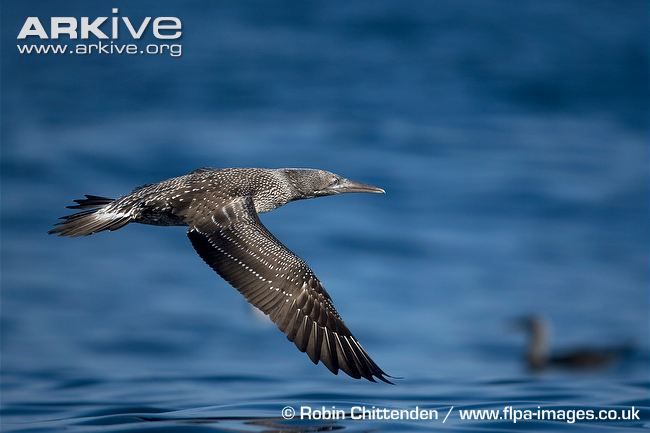
Predators of eggs and nestlings include Great Black-backed and Herring Gulls, Common Ravens, Ermine, and Red Fox. The only known habitual natural predator of adults is the Bald and White-tailed Eagles, though large sharks and seals may rarely snatch a gannet out at sea.
Old names for the Northern Gannet include Solan, Solan Goose, and Solant Bird.
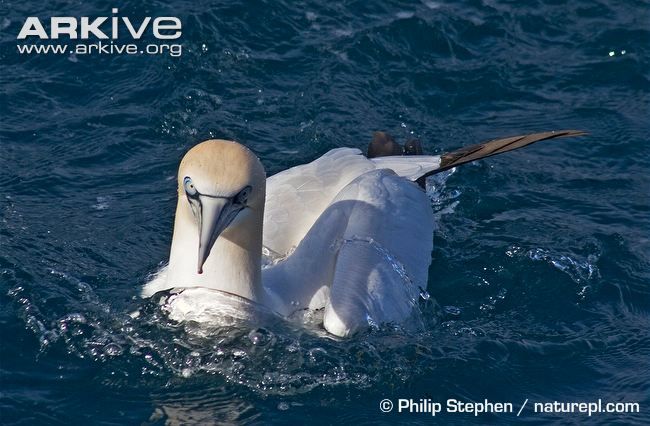

Scientific classification
Kingdom: Animalia
Phylum: Chordata
Class: Aves
Order: Suliformes
Family: Sulidae
Genus: Morus
Species: Morus bassanus
The Northern Gannet (Morus bassanus) is a seabird and is the largest member of the gannet family, Sulidae. It has the same colors as the Australasian Gannet and is similar in appearance. Nesting in colonies as large as 60,000 pairs, this bird is a spectacular high-speed diver.

Description
Young birds are dark brown in their first year, and gradually acquire more white in subsequent seasons until they reach maturity after five years.
Adults are 81–110 cm (32–43 in) long, weigh 2.2–3.6 kg (4.9–7.9 lb) and have a 165–180 cm (65–71 in) wingspan. Before fledging, the immature birds (at about 10 weeks of age) can weigh more than 4 kg (8.8 lb). Their plumage is white with black wing tips. The bill is light bluish. The eye is light blue, and it is surrounded by bare, black skin. During breeding, the head and neck are brushed in a delicate yellow.
Distribution

Their breeding range is the North Atlantic. They normally nest in large colonies, on cliffs overlooking the ocean or on small rocky islands. The largest colony of this bird, with over 60,000 couples, is found on Bonaventure Island, Quebec, but 68% of the world population breeds around the coasts of Great Britain and Ireland, with the largest colonies on the Bass Rock (whence the species' Latin name) and Boreray, St Kilda.
In the United Kingdom, Gannets are a protected species. However, a legal exception is made for the inhabitants of the district of Ness (also known as Nis) of the Isle of Lewis in Scotland's Outer Hebrides, who are allowed to cull up to 2,000 gannets (locally known as guga) annually to serve as a traditional local delicacy—the taste is described as fishy.
Many of these Gannets are taken from Sula Sgeir, which is itself named after them.

Ecology
Gannet pairs may remain together over several seasons. They perform elaborate greeting rituals at the nest, stretching their bills and necks skywards and gently tapping bills together.
They are migratory and most winter at sea, heading further south in the Atlantic.
When feeding, these birds are spectacular high-speed divers, plunging into the ocean from a height of 10–40 metres (33–130 ft), with their bodies straight and rigid, wings tucked close to the body but reaching back, extending beyond the tail, before piercing the water like an arrow. Their nearly vertical dive can reach speeds exceeding 100 km/h (60 mph) before entering the water, allowing them to penetrate 3–5 m (10–16 ft) below the surface, and occasionally swimming down to 12–15 m (40–50 ft). If the dive was successful, gannets will swallow the fish underwater before surfacing, and will never fly with the fish in its bill. Although they are strong and agile fliers, they are clumsy during takeoffs and landings.

They mainly eat fish 2.5–30.5 cm (0.98–12.0 in) in length which gather in groups near the surface. Virtually any small fish (roughly 80–90% of their diet) or other small pelagic species (largely squid) will be taken opportunistically. Various mackerel, cod, smelt, and herring species are most frequently taken.
Although Northern Gannet populations are now stable, their numbers were once greatly reduced due to loss of habitat, removal of eggs and killing of adults.

Predators of eggs and nestlings include Great Black-backed and Herring Gulls, Common Ravens, Ermine, and Red Fox. The only known habitual natural predator of adults is the Bald and White-tailed Eagles, though large sharks and seals may rarely snatch a gannet out at sea.
Old names for the Northern Gannet include Solan, Solan Goose, and Solant Bird.




